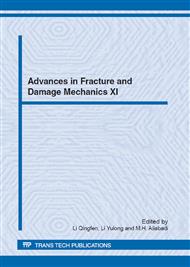p.45
p.49
p.53
p.57
p.61
p.65
p.69
p.73
p.77
The Influence of the Epoxy Interlayer on the Assessment of Failure Conditions of Push-Out Test Specimens
Abstract:
Connection between steel and concrete parts is frequently required in constructions where the steel-concrete joints are often realized by welded shear studs. In order to avoid stress concentrations, corrosion proneness, and other negative consequences of the welding process, steel-concrete connection without welded mechanical shear connectors is sought nowadays. Connection can be realized via an epoxy adhesive layer and gritted with granules. In the paper, the assessment of the push-out test configuration was performed from the generalized fracture mechanics point of view. The numerical-analytical modelling of a steel-concrete connection is performed without and with the epoxy interlayer, while 2D and 3D modelling is used. Thus conditions of crack initiation can be predicted from knowledge of the standard mechanical and fracture-mechanics properties of particular materials. The model of a bi-material notch with various geometry, and material properties is used to simulate various singular stress concentrators that can be responsible for failure initiation. Various manners of preparation of the epoxy interlayer are tested experimentally. Results of the fracture-mechanics studies are compared with each other and with experimental results. On the basis of the comparison, the 2D simulation of the steel-concrete connection without the epoxy interlayer is shown to be suitable for the estimation of failure conditions.
Info:
Periodical:
Pages:
61-64
Citation:
Online since:
November 2012
Price:
Сopyright:
© 2013 Trans Tech Publications Ltd. All Rights Reserved
Share:
Citation:


